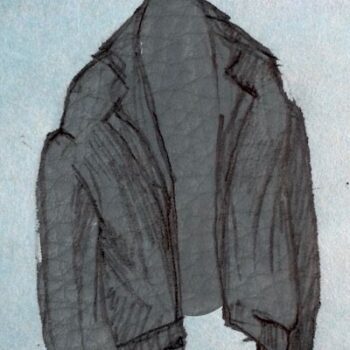
The boy is from a drug town, a rust belt town. It’s a violent town. Sometimes this violence looks like cops parked in front of the boy’s high school, but more often means city blocks with more foreclosed houses than not. It means driving past rusted out cars on roads more pocked up than the boy’s face six months into his second puberty. Living in this town means watching it die over the course of decades: streams of layoffs when a new pharmaceutical company moves in and ships jobs out, when the manufacturing plants close, when the local newspaper, a daily, stops printing. This town is fragile, prone to arson and meth lab explosions, luxury condo developments and commercial high rises.
The boy is fifteen and hasn’t told anyone he’s a boy yet, including himself. He’s sitting in Maddi Kay’s beat up Fuckmobile and she’s probably hitting on him, but he doesn’t know that, either. She reaches through the cracked window and points at the sole house slumped next to the road near the industrial district of the city.
“That’s Fight Club house,” she says, and like any other house in this part of town it may or may not be a drug house.
As the Fuckmobile rolls past Fight Club house, named because it resembles the one in David Fincher’s 1999 film, there are men sitting on the steps, smoking and drinking tallboys of beer from the brewery a few blocks away, in the cute part of downtown.
Maddi is eighteen and aggressive in her queerness. A few years later, she will tattoo the image of an open vein with the rainbow flag pouring out onto her left forearm. She is the first of many older queers to call the boy a baby butch, which, like his short-but-not-short-enough haircut and ill-fitting blouse, is almost right but not quite.
Fight Club house has two stories, and, like its film counterpart, sits isolated from other residential sections of town. Were the second floor windows not boarded up, the view would look out onto the research and development plant for a major pharmaceutical company, a grey seven-story modernist slab. The peeling strips of blue paint from the house’s vinyl siding are chipping off, alongside pale blue shingles from the peaked roof, onto rotting planks of wood on the porch. On hot summer days like this one, the planks buzz with cockroaches.
The men call out at Maddi, tell her how hot she is, and she flips them off, laughing. The boy shrinks into his seat, glad to have been allowed to pass unnoticed.
“What’re you so freaked by?” she says. “They’re just guys being guys. Don’t be afraid.”
*
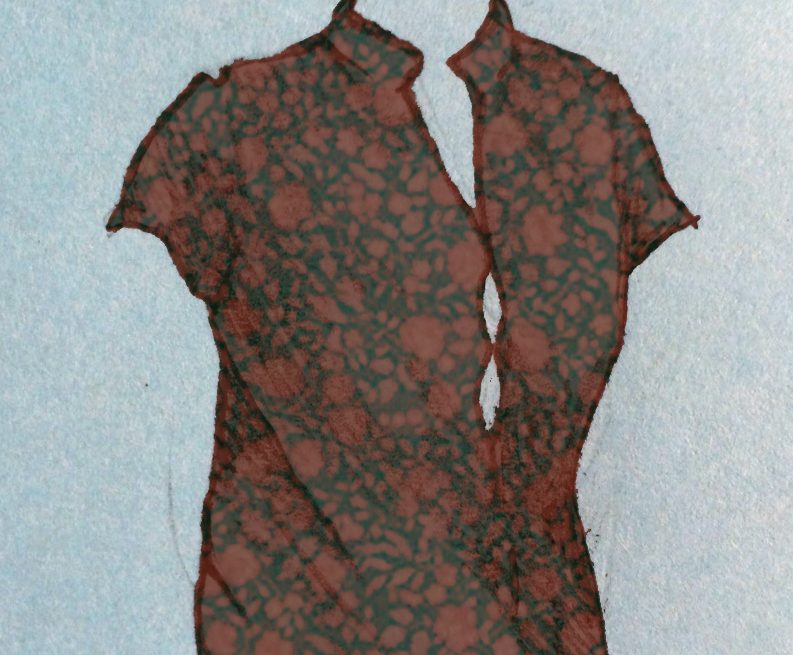 I wrote a story of myself and told it until it came true.
I wrote a story of myself and told it until it came true.
This is what the boy says when people ask him about being trans. There’s a romantic veneer to the phrase he’s always liked, a kind of self-made sensibility. In many ways, he’s a man of his own making: every two weeks he injects himself in an increasingly hairy thigh with testosterone.
Even before the shots, the boy wrote himself into existence within his journals (he couldn’t bear to call them “diaries,” because those were “too girly”): a loose sketch of his sixteen-year-old face captioned, “portrait of the artist as a young man dyke,” a rant about his body that catalogues it into bits that felt like his and bits that didn’t, ending with, “Am I trans? I don’t think so. Genderqueer? Maybe. But I don’t think of myself as male… more like not as female.”
I want to comfort him, to tell him what happens next: he gets out of that town, gets on hormones, makes peace with his body. Just as he wrote himself into being, I want to write him a happy ending. But I don’t know how true that story would be.
*
Fight Club was the boy’s favorite movie as a teenager. He was incredibly attracted to Tyler Durden, as embodied by an often sweaty and half-naked Brad Pitt, in the confusing in-between space of simultaneously wanting to be him and fuck him. To the boy, Tyler was the perfect form of self-creation: “All the ways you wish you could be, that’s me,” Tyler says to Edward Norton, who plays the film’s protagonist and nameless narrator. “I look like you wanna look, I fuck like you wanna fuck, I am smart, capable, and most importantly, I am free in all the ways that you are not.”
When the boy was five or six, his older brother came home from high school football and basketball games brandishing his cuts and bruises with pride. “War wounds,” he called them, sticking out a bloody leg and getting mud on the couch.
The boy would later do the same, pulling up the sleeve of his Little League softball jersey to show off the bat-shaped cloud of purple and green on his shoulder after a particularly rough game. Softball had always been his preferred method of working his body until it became a thing of its own, just a body, one that smelled like dirt and grass and whatever Gatorade the coaches bought to dump on it after the game—no longer his body. When he injured his shoulder at fourteen, the boy took to sending chips of white paint from his kitchen door flying onto the piss-yellow tile on the floor just to watch the bruises bloom under his knuckles.
“Self-improvement is masturbation,” Tyler says to the narrator, at this point rather gaunt, on a bus as the two leered at the Photoshopped model on an ad for Gucci underwear. “Now, self-destruction,” Tyler says, trailing off into a throaty snort.
*
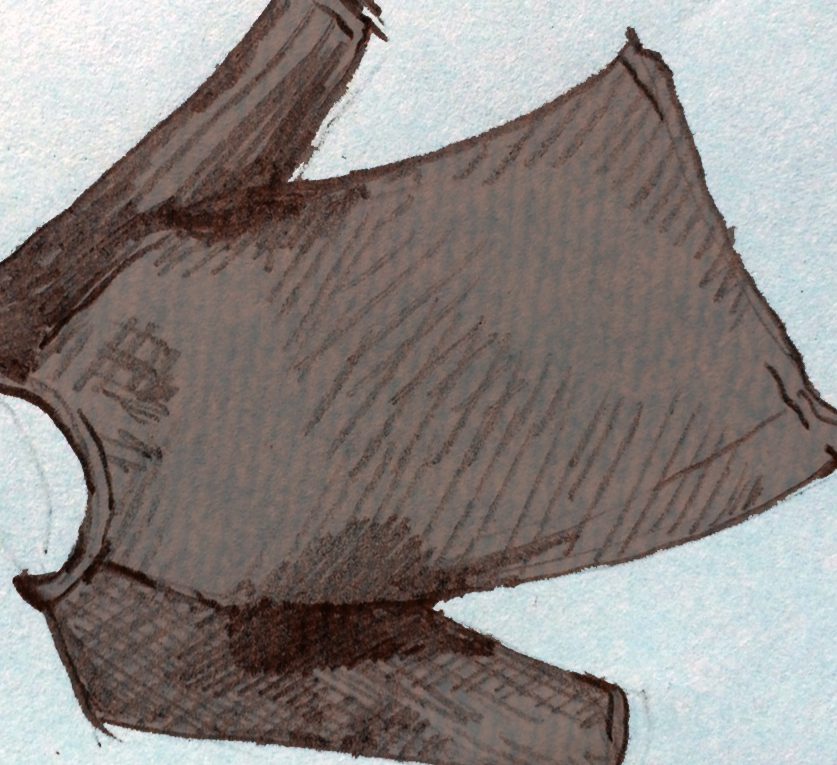 The day he gets his first shot of hormones, the boy is nineteen and living in New York. He is also on his period.
The day he gets his first shot of hormones, the boy is nineteen and living in New York. He is also on his period.
In honor of the occasion, the boy decides to try, for the first time, using a tampon so he can wear boxer briefs instead of the period panties he keeps stashed in the back of his dresser. The tampon is uncomfortable and the boy is too distracted by thoughts of leaking onto the clinic chair to notice the needle sink into his right thigh.
The nurse gives him a high five after it’s over for not complaining about the pain.
“It’s supposed to hurt to become,” he writes that night in his journal. “But that didn’t hurt.”
The testosterone will take months to become visible to anyone else. For now, the only sign of anything having changed is a Band-Aid stuck to the boy’s leg hair.
Does this make me a real man? Taking the shot or not feeling anything? the boy thinks, swapping out the tampon for a pad as soon as he gets home. He watches the blood drip into the toilet, catches his face reflected in the dirty water, and then rips off the bandage.
*
Masculinity defines itself by exclusion, a kind of dance at the edge of a subway platform for other men who howl “fuck you” into the roaring tunnel just to be louder than the train. This is what you are not, masculinity says to the boy as he stands in the furniture aisle of Target, not quite twenty and barely registering as “other men” to the guys brushing past his narrow frame.
“This pattern is okay,” he says to his ex-girlfriend of a bedspread. “If it wasn’t so girly,” he corrects.
*
At seventeen, the boy planned to dress up as Tyler Durden for a “spirit day” at his high school. Using the Fight Club poster hanging in his bedroom as a guide, he spent an hour meticulously gelling his hair into messy spikes, sneaking into his father’s closet to borrow a leather jacket, and using his mother’s eyeliner to draw the hint of facial hair along his cheekbones and jaw.
He felt like such a badass, licking his teeth and spitting into trashcans as he glowered through the hallways of his school. If only for the day, he thought of himself as something more powerful than his usual identity as the bookish poster lesbian—rainbow sweatbands and all—of the junior class.
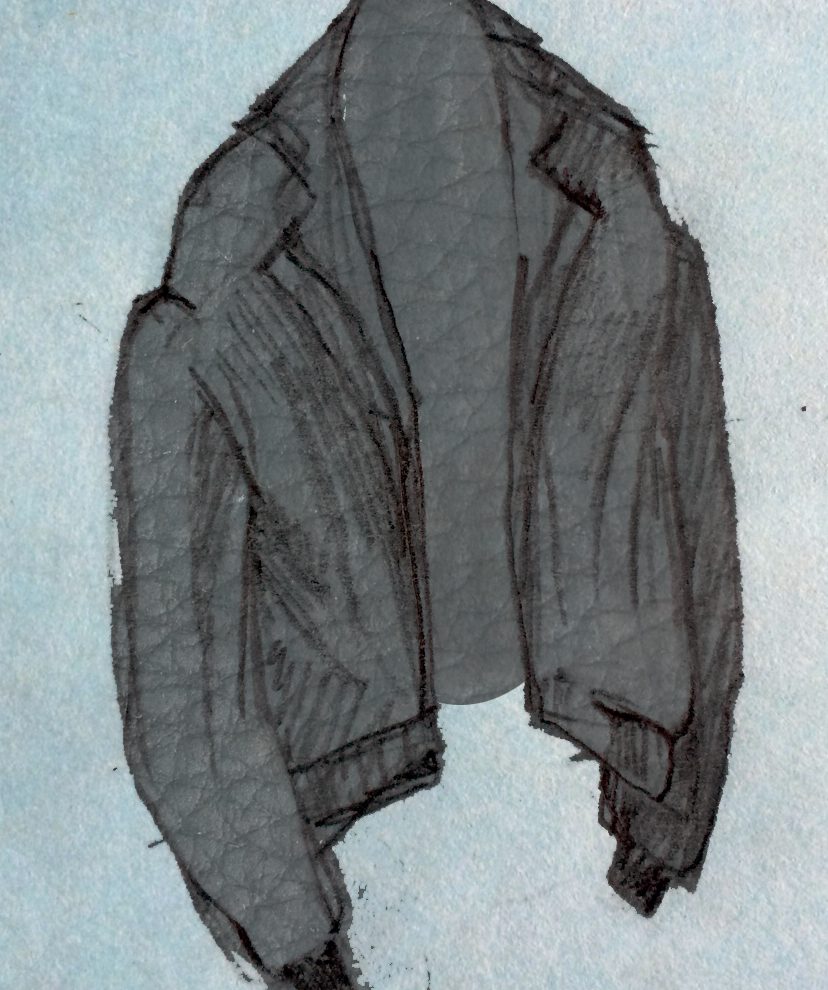 The gel made the boy’s hair floppy and crunchy, the jacket sagged around his narrow shoulders, and the streaks of brown eyeliner looked like shit smeared around his face. Because he didn’t have contacts or prescription sunglasses, he bought cheap aviators and wore them over his glasses, peering out at his classmates through a blurry grey fog.
The gel made the boy’s hair floppy and crunchy, the jacket sagged around his narrow shoulders, and the streaks of brown eyeliner looked like shit smeared around his face. Because he didn’t have contacts or prescription sunglasses, he bought cheap aviators and wore them over his glasses, peering out at his classmates through a blurry grey fog.
Toward the middle of the film, naked in a tub while Norton makes gestures toward personal hygiene, Tyler scoffs: “We’re a generation of men raised by women. I’m wondering if another woman is really the answer we need.” When Fight Club expands and becomes Project Mayhem, Tyler has the narrator harass potential recruits before they’re allowed to enter: “If the applicant is young, tell him he’s too young. Old, too old. Fat, too fat.” Those who refuse to be excluded get to be space monkeys that, like Tyler, typify the kind of working class masculinity the boy grew up around.
*
The boy has been on hormones for three years, but according to the rust belt, he is not a boy at all because he doesn’t have a piece of paper signed by a surgeon that says his tits have been cut off.
The typical transgender narrative demands a breaking point, an essential split from a former self. The boy, before the drugs, sometimes watched videos on YouTube to learn about other boys like him. These boys used words like “trapped” and “wrong” about their bodies before showing off their patchy facial hair or new workout routine. Most of them identified as straight.
My boy hates being called trapped, hates the typical transgender narrative—someone else’s story mapped onto his body—but still sometimes invents a twin sister to explain any pictures of himself before age twenty. Two weeks after telling everyone he was a man, he wrote, “Sometimes I feel like I’m killing my sister.”
Once my boy is tit-less, he will be able to say he is a boy on paper, but only after he submits a “correction” to his birth certificate, erasing any evidence that his “sister” ever existed in the first place. Unless, of course, he transfers his residence to a different state. A different kind of erasure.
*
In his mandatory session with a social worker before he can take the drugs that will change his body, the boy jokingly tells the kind-eyed therapist that he’s afraid of becoming a misogynistic asshole. This is partly true. He’s afraid of not being seen as queer anymore, of people looking at him and feeling the same fear he feels when he’s around most men, of being angry all the time. Most of all, he’s afraid that “man” is just the story he has to tell to get a skin he’d be able to live in.
Of course, the boy doesn’t say any of this. In order to get the drugs he has to say all of the right things, be absolutely sure of what he’s “getting himself into.” The boy, like any of the other boys and girls in mandatory therapy like this, has to prove he’s not too crazy, that he’s a real boy. The therapist laughs away the boy’s concerns, signing off on the transition and telling my boy that his anxiety about maleness and misogyny somehow absolves him of it.
*
Qdoba Mexican Grill, nineteen years old: baby boy, baby Alexander, only three months on testosterone, has a cracking voice and a face covered in rows of acne like bubble wrap. I want to pop his zits. It would only mess up his face more, but I like the satisfaction of the blood and pus oozing beneath my fingers. It feels like progress, tangible.
The boy’s oldest friend, Ben, is having trouble with my boy’s transition.
“I mean,” Ben says, picking pico de gallo out of his chicken, which he ordered so the boy wouldn’t call him boring. “What kind of normal girl would ever want to sleep with you?”
The boy steals a tortilla chip and crunches it thoughtfully, staring at Ben’s chin and realizing that even now, technically only a man for three months, he has more facial hair. “At least I get more pussy than you,” the boy says coldly, and high-fives his friends as they whistle and cheer.
*
What makes a man? The boy doesn’t know. For a few months, living uncomfortably in the liminal space between using his sister’s name and mine, he invented a figure called “the Esquire Man”: put-together, charming, effortless. “I see him in mirrors when I’m walking quickly enough on days cool enough to dress like myself,” the boy wrote during his first month of college in New York. The Esquire Man—whose wardrobe consisted of fitted button down shirts, suits, and ties—evolved out of the dapper queer aesthetic popular with the certain kind of woman he thought he was, a bridge between the body he had and the one he wanted.
“People do it every day,” Tyler Durden tells Fight Club’s shaking narrator as it becomes clear, late in the film, that he and Tyler are the same person. “They talk to themselves and see themselves as they’d like to be. They don’t have the courage you do to just run with it.”
The boy is full of stories he likes to tell himself. There’s something comforting about having a point of reference—this is who I am, who I’ve always been. It makes him feel less crazy; after all, he had to be diagnosed with gender identity disorder in order to get the drugs. The boy returns to his journals and notebooks like a kind of origin myth in order to feel genuine, in order to feel real.
I am the kind of man that wears deep v-necks, my boy says to himself, digging through a dresser drawer for a shirt and pulling out an old notebook entry regarding his love for that kind of tee written at age fifteen as proof.
*
The rust belt had always felt like a place that needed to be escaped.
“We went five minutes in the wrong direction and ended up in a cornfield, a goddamn cornfield,” the boy’s East Coast-born father once told him, describing an apartment-hunting trip shortly after he and the boy’s mother moved to this town for jobs at the local paper. “And then we did it again on the other side of town. I couldn’t believe it.”
When the boy was eighteen and applying to colleges, the newspaper closed down daily operations and abandoned its brand-new printing press, moving a few blocks away to a glass office full of plush chairs and flat screen televisions. As a kid, my boy used to wander the halls of his parents’ office, watching the giant rolls of paper lumber toward the presses. The building felt like it had a sense of history to it. Its public entrance had one of the original printing presses, back from 1837, encased in glass, and on the way to the newsroom, framed front-page prints of major events starting at World War I lined the hallway, leading up to the announcement of the paper’s 2009 “Newspaper of the Year” award near the managing editor’s desk. That front page had a picture of the entire newsroom, some eighty people, smiling and laughing.
Driving in circles around cornfields late at night with gas money earned from scrubbing toilets at his minimum wage janitorial gig, the boy swore he’d get out—get himself out—and never come back. He might not have been trapped in the wrong body, but listening to his father’s stories of teenage years wandering the East Village made him feel distinctly like he’d been trapped in the wrong town, in the wrong life. The night his mom lost her job, days after he sent off applications to schools out of state, he wrote, “There’s no future for me here.” Had he stayed, I don’t know if he would have grown up to be me.
*
Most of Fight Club’s locations are in varying stages of disrepair, from the dilapidated house shared by Tyler and the narrator to the grimy basements and back streets where the fighting itself takes place. “Everything is evolving, everything is falling apart,” Brad Pitt snarls over a techno beat on “This Is Your Life,” a track summarizing Tyler’s general philosophy from the film’s soundtrack. It’s a familiar kind of abandonment.
If anything has replaced the dream of 1950s industrial production, it’s images of industrial decay, an entire region defined by what it no longer is.
Every rust belt town is haunted by some version of its past. Detroit’s got cars. My boy’s town, two hours to the west, has insane asylums.
Almost fitting for the future home of the world’s largest pharmaceutical company, the boy’s drug town began as his state’s dumping ground for the mentally ill. It’s cut down the middle by a street that used to be named Asylum Avenue, which connects the drug plants downtown to the former grounds of the state’s biggest sanitarium near a lake that is still used to hide bodies.
The old TB treatment center (later bought by the state psychiatric hospital) is the most iconic remnant of this drug town’s ghosts. Growing up, the boy heard stories of his older brother’s friends sneaking in and tripping acid in the morgue or throwing snowballs off the roof. Too afraid to visit himself, he watched videos online, late at night and curled up on his parents’ couch. As with most ruin porn, paint peels from the walls like bits of skin after a burn. A toothless piano hangs out of a third story window, its legs broken and dangling. The rusted bones of bedframes are scattered throughout the hallways, beds used for twenty years of shock therapy. The surrounding forest looms in the background under a hazy grey sky and in some videos, police sirens are audible in the distance as the filmmakers scamper into the trees for safety.
Almost everything has been torn down now, bought out by the local university to use for a planned new medical school. Every few years, a cemetery will be moved to clear out space for real estate development and condos. The erasure, even to move creepy, asbestos-filled buildings, still feels like a kind of violence.
What happens to a place when it can no longer define itself by its history, when it tears everything down? What is the rust belt without the plants, the factories? Who is the boy without his sister?
*
There are days when I feel like the typical transgender narrative wants me to erase my own history, to discard the boy. Writing him down (into existence?) I am uneasy. I have reservations about calling him “he.” Perhaps I am oversimplifying, erasing the “she” that he, at one time, believed himself to be. I wonder if I am still killing my sister, that little girl with long brown hair and a smile that looks like mine.
In the final scenes of Fight Club, the narrator and Tyler square off for a last showdown in an ugly, abandoned room that reminds me of home. After brutally beating the narrator into submission, Tyler shouts, “Hey, you created me. I didn’t create some loser alter ego to make myself feel better. Take some responsibility!”
During my most recent viewing of the film, more than two years after the boy started hormones, I fell asleep a third of the way through, blinking in and out of consciousness in fragments. What struck me, more than any of Tyler’s antics, is that, of the twin protagonists, only Tyler gets to have a name. Who is the character? Does Tyler haunt the narrator, or the other way around? Am I haunted by the boy? Or am I the monster he was afraid of growing into—it feels like a cop out to put my words to Ben in that Qdoba in the boy’s mouth.
*
The film’s ending, in contrast to the book—where the narrator wakes up in a mental hospital, still surrounded by members of Project Mayhem—is, in a twisted way, happy. The narrator shoots himself in the head, seemingly destroying Tyler, and reaches for his love interest, Marla’s, hand while “Where Is My Mind” by The Pixies swells in the background and the credits roll. “You met me at a very strange time in my life,” the narrator says to Marla, suggesting that, with Tyler gone, things will start to look up. It’s a very heterosexual conclusion to a film littered with phallic imagery, from guns to literal dildos. The lost masculinity that Tyler laments is regained when the members of Fight Club, exclusively men, strip down to their pants and aggressively rub their sweaty bodies against each other. The self-destruction championed by Tyler is queer, and must be done away with for the narrator and Marla to live, Hollywood-style, happily ever after.
I replaced the Fight Club poster on my wall with a printout of a 1999 Rolling Stone cover released alongside the film. Brad Pitt is smoking a cigarette in a short-sleeved dress (bearing a banana-print between his legs with a single apple, a nod to the testicular cancer support group the narrator frequents before “meeting” Tyler) with his legs spread. Beside him is a bright yellow, yonic ashtray. Just as the boy was attracted to the leering Tyler in leather and bruises on the official poster, I find myself drawn to Brad in a dress.
*
The city is a body.
Actually, fuck that, the body isn’t a metaphor, the city is.
The body is a city.
I’m flattering myself. Where I’m from is only a city when I’m trying to pass as cosmopolitan.
The body is a town. My body is my town, my drug town. The pharmaceutical company that drove thousands of jobs overseas when it moved downtown a few blocks from Fight Club house is the same company that manufactures the testosterone slowly metabolizing in my endocrine system as I write my body onto these pages. My town’s drugs have made me, pushing my muscles outward and creating a hardness that still feels a little alien under my small hands. I like to clench those hands and watch the veins rise under the skin, highways branching out like the ones I drive late at night back in town, shouting myself hoarse to music the boy could never have sung along to.
Sometimes my guy friends back in the Midwest tell me that I have more facial hair and a deeper voice than they do because I’m cheating—the synthetic hormones give me more testosterone than a “real” boy. This is not how it works. Hormones merely activate genes that are already there, invisible twins that live within our skin.
Maybe the boy and I haunt each other, past and present ghosts mixed up in this patchwork body that’s still trying to figure out where home is.
*
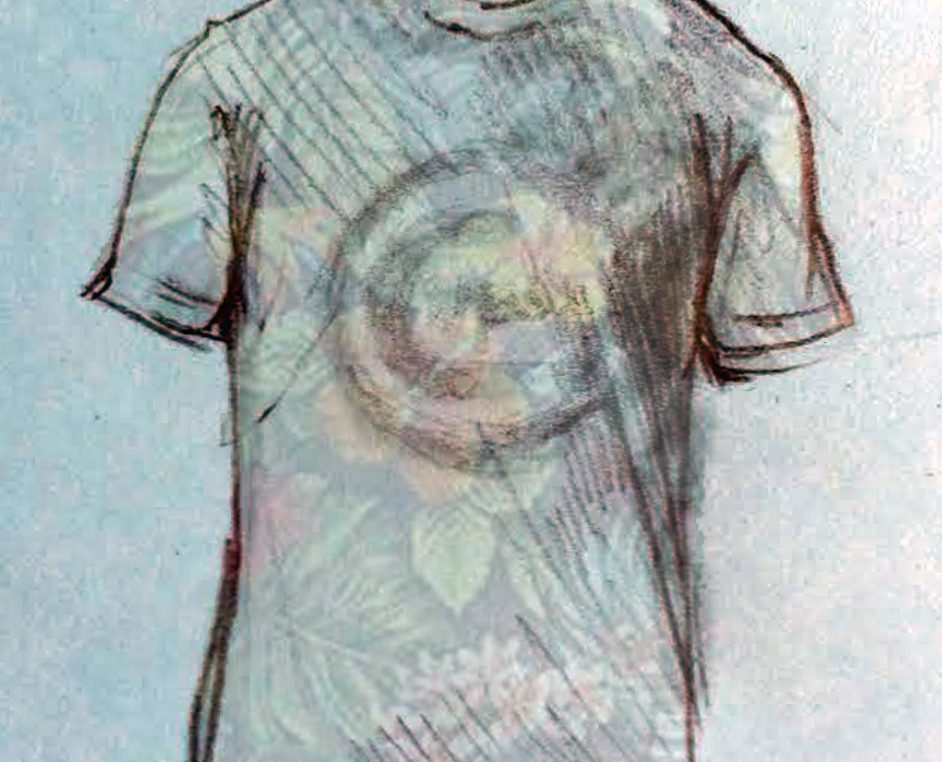 While the Esquire Man had always been a vision of himself the boy carried around like a future ghost to someday grow into, somewhere along the line the boy started abandoning his own origin myth. The vests and ties, markers of a world the boy never really felt was his, got traded in for his father’s faded blue Chicago Cubs tee shirt and black skinny jeans with floral hats, an aesthetic his friends call “Midwest hipster dork.”
While the Esquire Man had always been a vision of himself the boy carried around like a future ghost to someday grow into, somewhere along the line the boy started abandoning his own origin myth. The vests and ties, markers of a world the boy never really felt was his, got traded in for his father’s faded blue Chicago Cubs tee shirt and black skinny jeans with floral hats, an aesthetic his friends call “Midwest hipster dork.”
At twenty, and working as a resident advisor for a high school program, the boy painted his nails for the first time in fifteen years. The color he nervously picked out from the makeup aisle at his local drugstore matched the bursts of violet that used to swim under his knuckles. This is what masculinity can look like, he told his teenage boys.
There’s this barbershop the boy goes to near the East Village, the kind of place where the 80s never really died. It smells permanently of hair spray and pomade, and the hum of clippers competes with torch songs on the karaoke machine. It’s exactly the kind of place that would have scared the shit out of him at fifteen. But these days, the boy—who looks up nail polish tutorials as often as he searches for tips on dealing with his facial hair—folds his glasses neatly in his lap, and blindly trusts the barbers. He offers up his neck, his throat, all those fragile vital bits, to the men without complaint.
***
Rumpus original art by Heather Muntzer.




